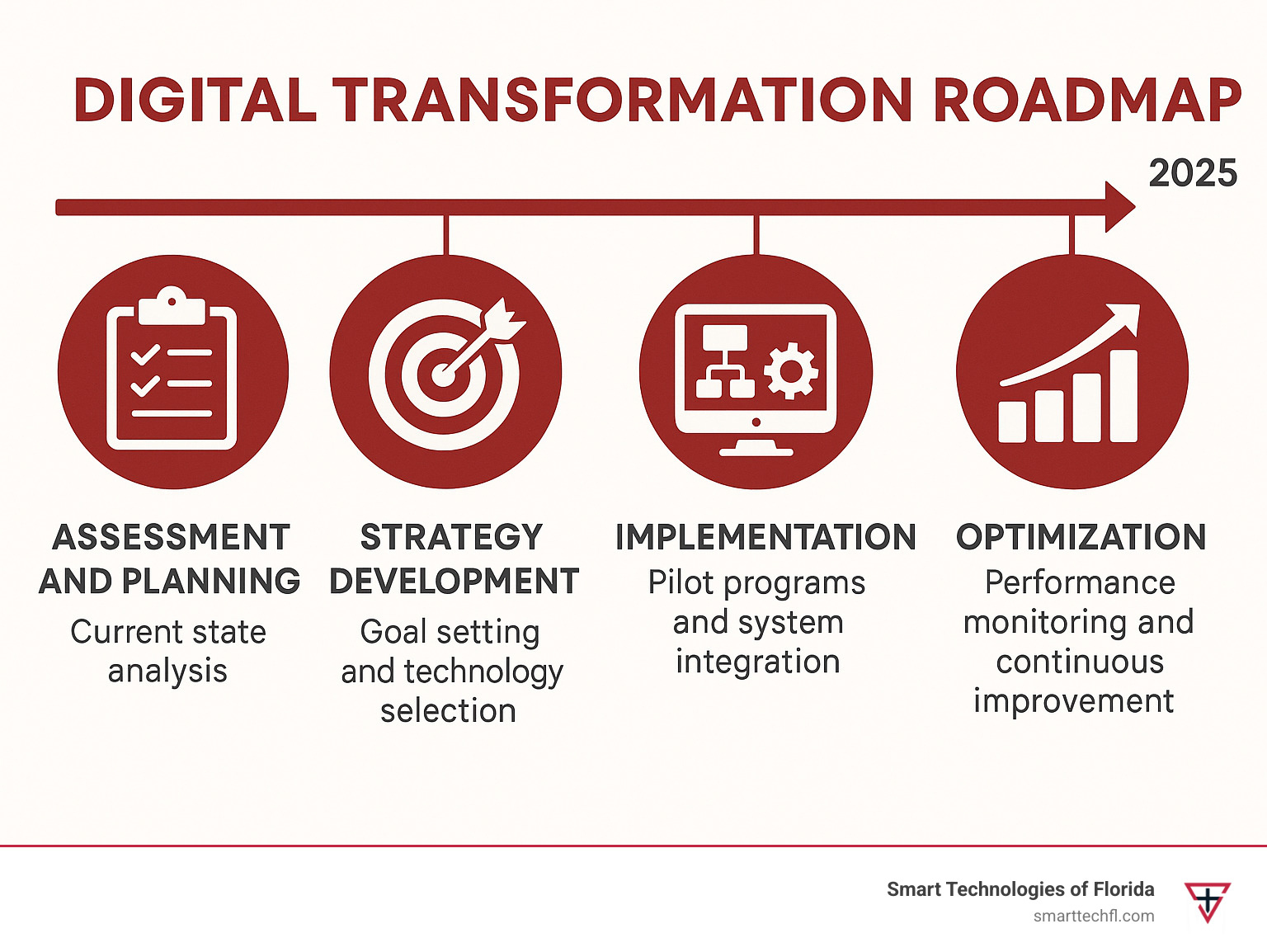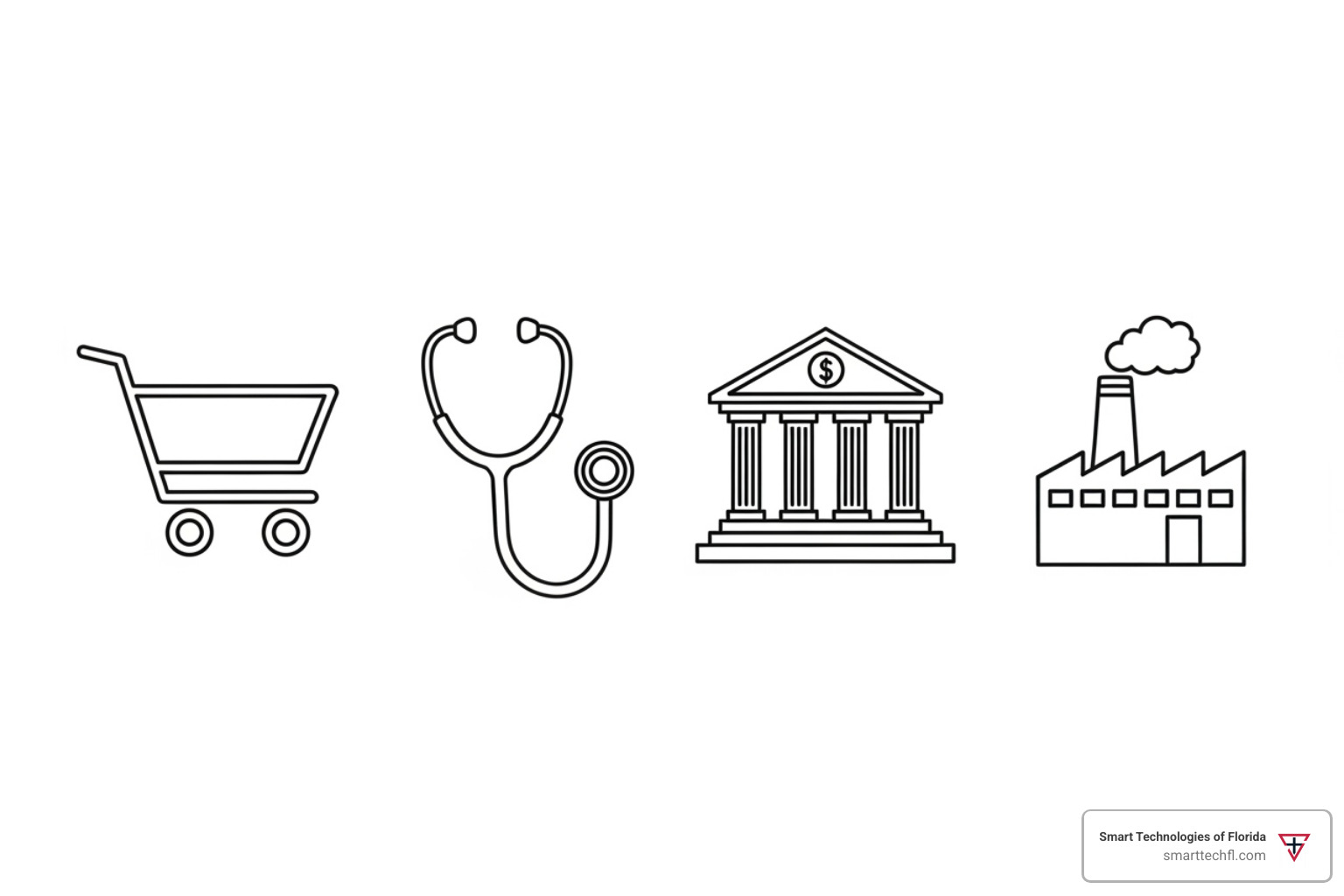The Essential Digital Transformation Roadmap for Modern Businesses
AI Overview:
Digital change has shifted from being a competitive advantage to a business survival requirement. Companies that fail to adapt digitally risk falling behind in a marketplace where customer expectations demand seamless, technology-driven experiences. With the global digital change market projected to grow from $2.71 trillion in 2024 to $12.35 trillion by 2032, standing still means moving backward.
Why Digital Change for Businesses is No Longer Optional
Digital change for businesses has shifted from a strategic advantage to a core survival requirement. In today’s marketplace, failing to adapt digitally means risking obsolescence. This isn’t just about adopting new tools; it’s a fundamental reimagining of how your organization operates, delivers value, and competes.
This involves:
- Integrating digital technology across all business areas.
- A cultural shift toward continuous experimentation and adaptation.
- A strategic approach to improve efficiency and customer experience.
The scale of this shift is massive. The global digital change market is projected to grow from $2.71 trillion in 2024 to $12.35 trillion by 2032, with 90% of organizations already engaged in some form of change.
However, the stakes are high: 70% of these initiatives fail, often due to unclear objectives and poor integration. For businesses, especially in competitive sectors like retail, customer expectations for seamless digital experiences are non-negotiable. Getting it right is critical, as companies with strong digital strategies see 65% greater annual returns than their peers.

What is Digital Change and Why Is It a Business Imperative?
Digital change for businesses is a comprehensive strategy that weaves technology into every aspect of your operations, from customer service to inventory management. It’s a fundamental rethinking of how your organization works, driven by a cultural shift that encourages experimentation and challenges old methods. This creates a powerful, hard-to-copy competitive advantage.
The numbers confirm the urgency. The global market for digital change for businesses is projected to soar from $2.71 trillion in 2024 to $12.35 trillion by 2032, a compound annual growth rate of 20.9%. With 90% of organizations already undertaking digital initiatives and funding now 2.5 times higher than in 2022, inaction means falling behind. As the digital economy’s growth accelerates, standing still is moving backward.
The Core Benefits of Embracing Digital Change
When we guide businesses through digital change, the benefits are tangible and impact the bottom line.
- Improved customer experience: Digital tools enable personalized, seamless customer journeys that build loyalty.
- Improved productivity: Automating repetitive tasks frees your team to focus on strategic work that drives growth.
- Data-driven decision-making: Clear insights replace guesswork, leading to better strategies and resource allocation.
- Increased agility: A digital foundation allows your business to pivot quickly in response to market shifts or crises.
- New revenue streams: Digital platforms can open up entirely new ways to serve customers and generate income.
- Strengthened data protection: Modern digital systems come with robust cybersecurity measures to protect sensitive information.
At Smart Technologies of Florida, our people-centric approach ensures these benefits are fully realized. We empower your team to use new tools effectively. For more on automation, see our Business Process Automation Solutions.
How Change Varies Across Industries

While the principles of digital change for businesses are universal, the application is industry-specific.
- Retail: Focuses on e-commerce, AI-driven personalization, and connecting online and in-store experiences.
- Healthcare: Accepts telemedicine, electronic health records, and AI for diagnostics to improve access and quality of care.
- Financial services: Shifts to mobile banking, digital wallets, and AI-powered fraud detection for secure, convenient transactions.
- Manufacturing: Leverages the Internet of Things (IoT) for predictive maintenance and digital simulations to optimize production.
Our 23 years of experience have shown that success depends on understanding these nuances. Our personalized services approach ensures the technology strategy fits your unique industry challenges and customer expectations.
The Core Pillars of a Successful Digital Change for Businesses
Successful digital change for businesses rests on three interconnected pillars: People, Process, and Technology. Like building a house, all elements must work in harmony. Neglecting one pillar undermines the entire structure. After 23 years of guiding organizations, we’ve seen that this balanced approach is what makes change stick.

When these pillars are aligned, technology is acceptd, processes flow smoothly, and real problems get solved. This holistic strategy embeds digital change into your company’s DNA.
Pillar 1: People and Leadership
This is where most digital initiatives succeed or fail. Without your team’s buy-in, the best technology is useless. Digital change for businesses demands a cultural shift where employees feel safe to experiment and challenge old norms.
- Leadership: Executives must champion the vision, while department heads translate it into daily actions.
- Employee Upskilling: Investing in your team’s skills is critical. Confident, capable employees become advocates for change.
- Change Management: Clear communication is key. Projects with excellent change management are six times more likely to succeed.
- Collaboration: Breaking down departmental silos ensures everyone is working toward the same goals.
Our people-centric approach makes your team partners in the change. Learn more in our Business Communication Solutions Guide for Businesses.
Pillar 2: Process and Agility
Great people and technology are hampered by outdated processes. Optimizing workflows is essential to realizing the benefits of digital change for businesses.
- Workflow Automation: Automating repetitive tasks frees up your team for more strategic, creative work.
- Agile Methodologies: Instead of rigid, long-term plans, agile approaches allow for quick iterations, feedback, and flexibility.
- Operational Resilience: Digital processes, especially in the cloud, build in redundancies that keep your business running during disruptions.
- Customer Journey Mapping: Understanding every customer touchpoint helps you remove friction and create better experiences.
- Eliminating Data Silos: Ensuring information flows freely between departments enables better decision-making for everyone.
These improvements create a more responsive organization. Find more in our guide on Streamlining Business Processes for Efficiency.
Pillar 3: Key Technologies Driving Digital Change for Businesses
While it’s more than just tech, the right tools are the engine of digital change for businesses.
- Cloud Computing: Provides the scalable, flexible, and cost-efficient backbone for modern operations.
- Artificial Intelligence (AI) and Machine Learning: Uncovers insights, personalizes experiences, and automates complex tasks.
- Internet of Things (IoT): Connects physical assets to digital systems for real-time monitoring and control.
- Data Analytics: Transforms raw data into actionable insights for strategic decision-making.
- Cybersecurity: A non-negotiable element to protect your data, customers, and reputation as your digital footprint grows.
The key is to choose technologies that align with your business goals. Explore our IT Infrastructure Solutions Guide for more.
Building Your Digital Change Framework: A Step-by-Step Guide
Successful digital change for businesses requires a blueprint. A structured framework ensures every initiative aligns with your business goals and delivers measurable value. This isn’t a one-time project but a continuous process of tending and optimizing.
At Smart Technologies of Florida, our 23 years of experience have shaped a people-centric approach that creates a roadmap that is both technically sound and practically achievable. We focus on strategic alignment and phased implementation for continuous improvement. Explore our Digital Change Consulting Services to see how we can guide you.
Step 1: Strategy and Planning
This foundational phase sets you up for success. It’s where vision meets a concrete plan.
- Define Clear Objectives: Start by defining what you want to achieve with specific, measurable, achievable, relevant, and time-bound (SMART) goals. Unclear objectives are a top reason for failure.
- Ensure Stakeholder Alignment: Get buy-in from everyone, from leadership to frontline employees. Alignment is essential for smooth execution.
- Establish a Budget: Plan for all costs, including software, training, and change management. Funding for these initiatives is now 2.5 times higher than in 2022.
- Conduct a Risk Assessment: Identify potential pitfalls—like team resistance or integration issues—early on so you can develop mitigation strategies.
- Choose the Right Partners: Select technology and partners that are scalable and aligned with your long-term vision.
For help modernizing your tech, see our guide on Technology Upgrade for Businesses.
Step 2: Implementation and Execution
This is where your digital vision comes to life. Our agile approach ensures flexibility and continuous feedback.

- Use Agile Project Management: Break the project into smaller, manageable phases for faster iteration and the ability to adapt to new insights.
- Run Pilot Programs: Test changes on a small scale first to work out bugs and refine processes in a controlled environment before a full rollout.
- Drive User Adoption: Focus on intuitive design and proper training. Technology is only valuable if your team uses it effectively.
- Manage Data Migration: Carefully plan the transfer of your valuable data to ensure its integrity and minimize operational disruption.
- Integrate Systems: Ensure new digital tools work seamlessly with your existing infrastructure to eliminate data silos.
Our Managed IT Services can support you through every step of implementation.
Step 3: Measurement and Optimization
Implementation isn’t the end. Continuous measurement and optimization are crucial for long-term success.
- Track Key Performance Indicators (KPIs): Establish clear metrics tied to your objectives, focusing on value creation (revenue, costs), team health (engagement), and change progress (adoption rates).
- Conduct ROI Analysis: Connect every dollar spent to tangible financial results to justify investments and guide future strategy.
- Monitor Customer and Employee Feedback: Use surveys and direct feedback to understand the real-world impact of your changes and identify areas for improvement.
- Make Iterative Improvements: Use the data and feedback you collect to continuously refine your digital strategies, ensuring they remain effective as your business evolves.
This ongoing optimization is where the real value is open uped. Learn how Managed IT Solutions Improve Efficiency and support this cycle.
Digital change for businesses is a journey with inevitable bumps. The most successful companies don’t avoid challenges; they anticipate and plan for them. With 23 years of experience, we at Smart Technologies of Florida have learned that viewing obstacles as learning opportunities is key to building resilience.
Future-proofing your organization means creating an adaptive strategy from day one. It’s about developing a culture of continuous improvement and innovation that can evolve with the market.
Overcoming Common Challenges in Digital Change for Businesses
The fact that 70% of digital change initiatives fail isn’t a deterrent—it’s a roadmap of pitfalls to avoid.
- Resistance to Change: This is a human, not technical, problem. Transparency about the ‘why’ behind changes and how they benefit employees can turn resistance into enthusiasm.
- Lack of Clear Vision: 54% of executives cite unclear objectives as a primary cause of failure. A clear, shared vision is essential.
- Integration Issues: 44% of leaders report that making new tools work with legacy systems is a major obstacle. This requires technical expertise and careful planning.
- Data Quality Problems: Feeding poor-quality data into new systems leads to flawed results. Data cleansing and organization must come first.
- Cybersecurity Threats: A larger digital footprint increases vulnerability. Security must be a core component of your strategy, not an afterthought.
These challenges are manageable with the right partner and a people-centric methodology designed to address them head-on.
How AI is Shaping the Future of Business Change
Artificial Intelligence is a game-changer for digital change for businesses. It’s not just another tool; it’s a force that redefines what’s possible.
- AI-Driven Insights: AI can analyze vast amounts of data to spot trends and predict customer needs in ways humans can’t.
- Generative AI Applications: This technology can create personalized marketing content, product prototypes, and more, accelerating innovation.
- Predictive Analytics: AI takes the guesswork out of decisions, from identifying at-risk customers to optimizing supply chains in real-time.
- Intelligent Automation: AI-powered systems can handle complex cognitive tasks, freeing up human experts for higher-value work.
- Personalization at Scale: AI allows you to deliver individually custom experiences to thousands of customers simultaneously.
Companies strategically integrating AI are setting a new pace for competition. Learn how this can transform your operations with our Business Process Automation solutions.
Frequently Asked Questions about Digital Change
Starting on a digital journey can feel daunting. From our 23 years of experience, here are answers to the most common questions we hear from business owners about digital change for businesses.
What are the first steps a small business should take in digital change?
For small businesses, the key is to start small and be strategic. Don't try to change everything at once.
Start with a specific problem: Focus on a clear pain point, like a slow checkout process or inefficient inventory management. This provides direction and measurable goals.
Focus on the customer: Ask how digital tools can create a better, easier experience for your customers. This often delivers the quickest wins.
Accept cloud-based solutions: Use affordable, scalable tools for customer management, accounting, or team communication that don't require deep IT expertise.
Prioritize high-impact, low-cost tools: Look for solutions that offer significant benefits without a massive upfront investment.
Seek expert guidance: Partnering with an expert helps you avoid costly mistakes and find solutions custom to your needs and budget.
How do you create a culture that accepts digital change?
Building a culture that welcomes digital change for businesses is more about people than technology.
Lead by example: When leaders actively use new tools, it signals commitment to the entire team.
Communicate the 'why': Clearly explain the reasons for the change and the benefits for both the business and individual employees.
Encourage experimentation: Create a safe environment where team members can learn and make mistakes without fear of judgment.
Invest in training: Provide proper training and ongoing support to build confidence and competence with new tools.
Celebrate champions: Recognize and reward employees who accept new technologies and drive innovation.
What is the difference between digitization, digitalization, and digital change?
Understanding these terms helps clarify your business's journey. They represent different stages of evolution.
Digitization: This is the simple conversion of information from analog to digital. Think of scanning a paper document into a PDF. The format changes, but the process doesn't.
Digitalization: This is using digital technology to improve existing business processes. For example, using software to automatically route and approve that digitized PDF invoice. The process becomes more efficient.
Digital Change: This is a fundamental reimagining of your entire business model, culture, and customer value proposition, driven by digital opportunities. It's not just about doing things better; it's about doing new things and creating new value.
In short: digitization changes your data, digitalization changes your processes, and digital change for businesses changes your entire company.
Conclusion
Digital change for businesses is not a final destination but a continuous journey of innovation. It’s about fundamentally reimagining your business to improve efficiency, improve customer experiences, and drive growth. While 70% of initiatives fail due to poor planning, a strategic, people-centric approach turns this challenge into a powerful competitive advantage.
The outcomes are clear: improved customer loyalty, streamlined operations, data-driven decisions, and new revenue streams. These are the results of well-executed digital change.
At Smart Technologies of Florida, our 23 years of experience have proven that success comes when technology serves people. Our people-centric approach ensures every solution empowers your team and aligns with your unique goals. We guide businesses in Daytona Beach, FL, and beyond through every step of this transformative journey.
The digital economy is growing at 20.9% annually. Your competitors are moving, and your customers expect digital-first experiences. The question is not if you will accept digital change, but when. You don’t have to steer it alone.
Take the next step in your change with Managed IT Solutions.












